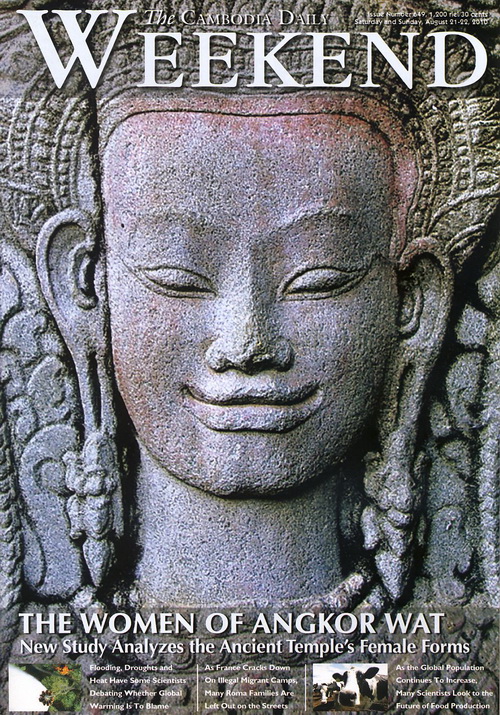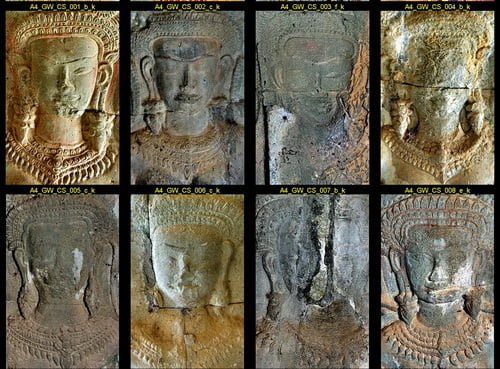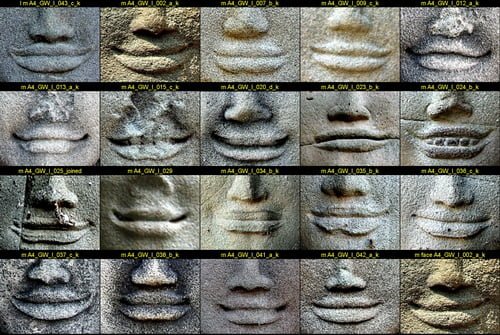Angkor Wat Women – Historical Insight on the Temple’s Female Imagery
The Angkor Wat Women
A New Study Offers Historical Insight
on the Temple’s Female Imagery
By Michelle Vachon – The Cambodia Daily
Click here for PDF Version (1.6 meg)
© 2010 The Cambodia Daily – This article appears with the permission
of the copyright holder. No further reproduction is permitted.

In 1927, Sappho Marchal, the 23-year-old daughter of Henri Marchal who was overseeing restoration of monuments at Angkor Wat at the time, published a book on the hairstyles, clothes and jewelry of 1,737 sculptures she had located on the walls and columns of Angkor Wat women.
And until recently, no archeologist or historian at Angkor had wondered why so many nearly life-size images of human beings filled the 12th century monument and why these sculptures were only of women, said Kent Davis, a researcher and publisher of DatAsia Press.
“Despite 150 years of intense study, the Khmer pundits who surveyed every temple and measured every stone only thought to consider these women as decorations, rather than as people.” Mr Davis said.
“Visitors were apparently content when the experts told them that the most complex collection of full-body portrait carvings ever created in a single ancient human generation were simply ‘Imaginary wives to serve the king in heaven’ Total nonsense, but it flew for 150 years.”

One researcher had written a short essay on the resemblance between the features on a few sculptures and hill tribe women.
Another had viewed the sculptures in a mythological context but without going further, he said.
So Mr Davis embarked on his own research in 2005, eventually getting in touch with art historian Peter Sharrock and archaeologist Robert McCarthy, who are studying these woman sculptures but concentrating on the era of Jayavarman VII, which took place about two generations after the construction of Angkor Wat.

Scholars refer to the women as devatas (deities), when portrayed in large sculptures, and apsaras (dancers and singers of the gods), when groups appear in smaller sculptures.
Mr Davis has identified 1,796 sculpted images on Angkor Wat through his research, expanding on inventories done by stone conservators with the German Apsara Conservation Project.
Once Mr Davis took digital photos of the group, he asked a team from Michigan State University in the US for help developing a computer tool to analyze the sculptures.
This has prompted the first scientific study to be conducted on Angkor Wat’s women figures. Its results will be presented on Sunday in Istanbul at the conference of the International Association for Pattern Recognition on computer vision.

Anil K. Jain — a professor in several of the university’s departments including computer science and engineering, statistics and probability — will explain the computer analysis model that he and two of his students developed to analyze the features of women sculpted on the surface of the monument.
For this first study, Mr Jain and his team concentrated on 252 devatas located on Angkor Wat’s entrance pavilion called the West Gopura.
As they mention in the summary of their study entitled “Clustering Face Carvings: Exploring the Devatas of Angkor Wat [925k PDF download],” Mr Jain and his team had to devise a program to compare devatas on well preserved as well as eroded stone and on different types of stone, which some existing programs did not make possible.

They designed the tool to analyze whole faces, proportions in features, such as the distance between the eyes or between nose and mouth, as well as specific features including ears and chins. This program will also give future researchers the flexibility to change features to be analyzed.
“While the landmarks for many different facial components were marked, in this study we used only four of the major facial components (eyes, nose, mouth and face outline) for clustering the devatas into 8 groups,” they write in their summary. [see bottom of article for composites of facial feature variations]
These groups of devatas sharing specific features may reflect the features of women who actually lived at Angkor at the time and the fact that they came from different regions such as central Cambodia, Laos, northerncentral Thailand, Champa in today’s Vietnam, and China.

“There is [a report from the year 1225] in China which says 200 foreign women danced and made offerings to the Buddha in Jayavarman VII’s temples. So Angkor was an international center,” Mr Sharrock wrote in an e-mail.
However, whether these eight groups of devatas correspond to women who lived at Angkor when the temple was built has yet to be seen, he said, “These are early results only. More tuning and more data manipulation is needed before strong claims can be made.”
In Mr McCarthy’s opinion, the sculptures may be idealized versions of living women who served as royal temple caretakers.
“The possibility that the role of guardian was taken by both female (in the majority) and male (in the minority) should not be ignored. Just as age and region of origin within the Khmer Empire does not appear to be a problematic factor within the devata community of temple guardians,” he wrote in an email.

Both Mr Sharrock and Mr McCarthy agree that this computer analysis tool shows great potential.
“In Angkor Wat there are clearly differences between the elaborately coiffed devata inside the outer western gallery and inside the courtyards of the main temple and the more powerful, larger and more serious-faced devata on the higher level of the temple and the central tower. Why there are these differences we do not yet understand.” Mr Sharrock said Mr Davis’ research with this computer program may help answer some of those questions, he added.
When analysis expands to include more features such as headdresses, jewelry, hands and feet, the differences from one to the other image may help, Mr McCarthy said, “unlock secrets of not only the devata of Angkor Wat but those earlier and later devata traits […] to assist in identifying artistic techniques that may lead to the identity, in unique styles only, of the craft people who supervised and those who carved the bas-reliefs.”
Mr Davis’ goal is to include Mr Jain’s program in a comprehensive database of Angkor Wat’s 1,796 sculpted images of women that tracks 65 characteristics — including location, features, compass orientation, hair styles, jewelry designs, hand positions, fabric patterns — of each image, he said.
He is now editing in a book [Daughters of Angkor Wat] compiling researcher’s opinions and speculations regarding the devata sculptures over the past 100 years.
***
Facial Feature Variations




